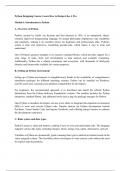Class notes
Python Designing Course: Learn How to Design Like A Pro
- Course
- Institution
Python is a high-level, versatile programming language known for its simplicity and readability. This dossier serves as a primer for those new to Python, providing an overview of its features, instructions for setting up a Python environment, an exploration of basic syntax and data types, an introd...
[Show more]



